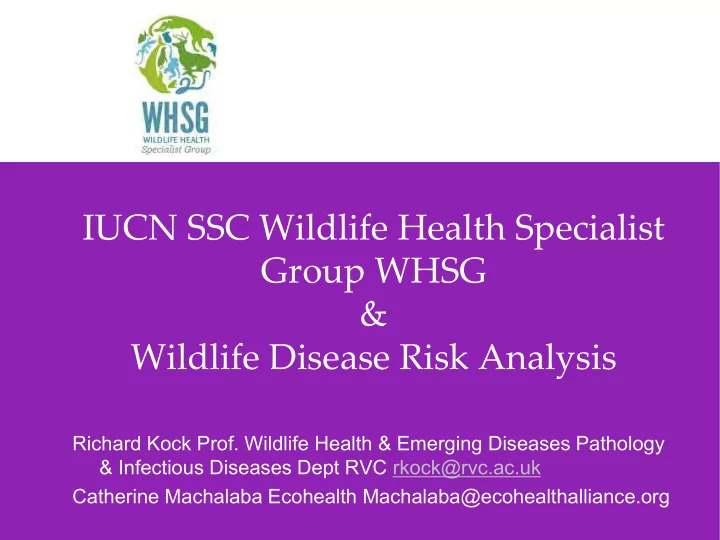

IUCN SSC Wildlife Health Specialist Group WHSG & Wildlife Disease Risk Analysis Richard Kock Prof. Wildlife Health & Emerging Diseases Pathology & Infectious Diseases Dept RVC rkock@rvc.ac.uk Catherine Machalaba Ecohealth Machalaba@ecohealthalliance.org
WHSG http://www.iucn-whsg.org/
DRA – A means for conserving wildlife and biodiversity DRA applied ad hoc currently Wildlife DRA developed to standardise the approach Guidance on when, where and why Decision makers can benefit from wDRA where cases of disease involve wildlife populations e.g. Associated with movement of animals, products, ecotoxicology, population declines, risks from wildlife interactions with people and domestic animals.
Target audience • Conservation organisations • Public Health Agencies • Strategic planners • Government agencies • Students of DRA, epidemiologists, wildlife veterinarians, disease biologists • Etc.
DRA Cycle
The last & most important stage
Disease Risk Analysis being used to help guide future planning & to improve future outcomes with Riintroductions of bighorn sheep (USDA 2006)
Disease Risk Analysis being used to assess spread/impact Bd to unaffected populations & proposed to help raise awareness about Bsal risk to the Americas
The addition of DRA to industrial & Agricultural Development could help to identify potential Disease risks such as nipah, Ebola & other Viruses & guide risk mitigation strategies to prevent an outbreak
A full DRA for bushmeat & other wildlife products Intended for trade would include the risk of acquiring Animals, handling & transport, consumption & or Use The implementation of disease prevention Strategies, & the identification of relative risks of Various products & uses.
DRA was never applied to the HPAI problem & wild birds. If this had been done it would have shown the likelihood of wild bird maintenance of the virus (negligible risk) & risk of transmission to poultry of HPAI (negligible risk) & help to focus on the role of poultry in driving emergence & evolution of new HPAI viruses.
The failure of the EC to conduct a DRA in consideration of the IUCN & other’s concern over licencing of Diclofenac for veterinary use in European countries is scandalous
Our membership’s concerns Middle East and North Africa: avian influenza through illegal imports and migratory birds (Jaime Samour). Africa: toxicity/poisoning issue around vultures and other connected species. (Holly Dublin and Leo Niskanen) Pakistan: Tuberculosis and Anthrax (M. Tariq Javed) India: Species specific disease in Indian Civets, (Prof Francis Xavier). Central Asia: considerable die-off of ungulates has taken place in recent years. Markhor in Tajikistan and the Saiga in Kazakhstan (Raffael Aye). Antimicrobial resistance: it would be good to see more on overall topic of antimicrobial resistance (Stephanie Norman). Ethics: Ethics of captivity in light of health ailments (R.S. Kishtwaria). Amphibians: Bsal and the concern for the bio-diverse salamanders of North America should/when it enters (Sharon Deem; Paolo Martelli).
Issues Submitted by Members for WPC TB in elephants in Nepal (Toshio Tsubota) Rabies Namibia kudu rabies (Laurie Marker) Disease Surveillance: TB (especially avian) and RVF. Climate change and the resurgence of insect-borne diseases: surveillance and diagnostics. Accelerating wildlife/human interface in the tropical African forests with regards to Filovirus epidemics: growing human population and food safety changing bat ecology - logging, deforestation and climate change. Role of zoos in disease surveillance growing urban interface and an opportunity to detect disease in both humans and animals (Emily Lane) Vultures: Plight of vultures in Africa - poisons diclofenac, powerline casualties windpower, traditional medicine, loss of habitat and food resources hang- gliding over the nesting cliffs. (Peter Turnbull) Carnivores: the ferret distemper vaccine is no longer being produced (Paolo Martelli) Canine distemper virus in tigers (Martin Gilbert). Rare earth toxicities are poorly studied (Paolo Martelli). Diclofenac approval for veterinary use in Europe (Andrew Breed) Position on Brucella ceti in cetaceans in wildlife and captivity (Gaby Hernandez) Kenya Wildlife Threats: PPR (Isaac Leko)
Membership suggestions on IUCN SSC activities De-extinction for Conservation Benefit: conservation has numerous more pressing issues than de- extinction, including conservation and restoration of key habitats, including wildlife diseases and many others... (Raffael Aye). On the tasks of the WHSG: We should interact with all other specialist groups. Recent Saiga mortality, Amphibian decline, Ruminant PPR mortality, ... show importance of this fact. (Sasan Fereidouni) Climate Change SG: I think it would be useful to produce information, tools and guidance documents for consideration of the impacts of Climate Change on wildlife health (perhaps produced in conjunction with the WHSG) (Mariano Gimenez Dixon).
Priority Issues Submitted from WHSG Chairs to the SSC Policy SubCommittee (July 2015) Saiga Antelope die-off in Central Kazakhstan: Outbreak investigation and Ecological/Environmental assessment in progress Specimen movement for disease diagnostics hindered by CITES regulations – need for solution to enable efficient movement to promote timely diagnostics and response Diclofenac (published paper in Science Dec. 2014) Unregulated use of poisons and toxins Endorsed tools to help policy makers and natural resource managers better anticipate and prevent disease risk (e.g. OIE-IUCN Guidelines to Wildlife Disease Risk Analysis )
Saiga Antelope
Saiga Population
Chronology of calving, outbreaks & level of mortality in investigated outbreaks Chronology Calving Die off Fatality Total no. Turgai 6 th - 17 th 10-18 th 100% 61,852 May May Tengiz 16 th - 20-26 th 100% 8500+/- 24 th May May Total mortality officially 148,800 out of 250,000 in 13 discrete calving aggregations in Central population but clearly many more than this….not all counted
A working group has been set up under the Ministry of Agriculture to examine the causes of this die-off, with International membership & support from CMS, IUCN, FAO, NGOs, Academic institutions & laboratories. A full Evidence review is being undertaken under a NERC Emergency grant (Pi rkock@rvc.ac.uk)
Conclusion DRA provides a standardised approach to decision making based on qualitative and where appropriate quantitative analysis. Any reasonably competent person or group can undertake DRAw but more quantitative methods require specific training IUCN/OIE are providing training opportunities over the next few years.
Acknowledgements Co-editors
Recommend
More recommend